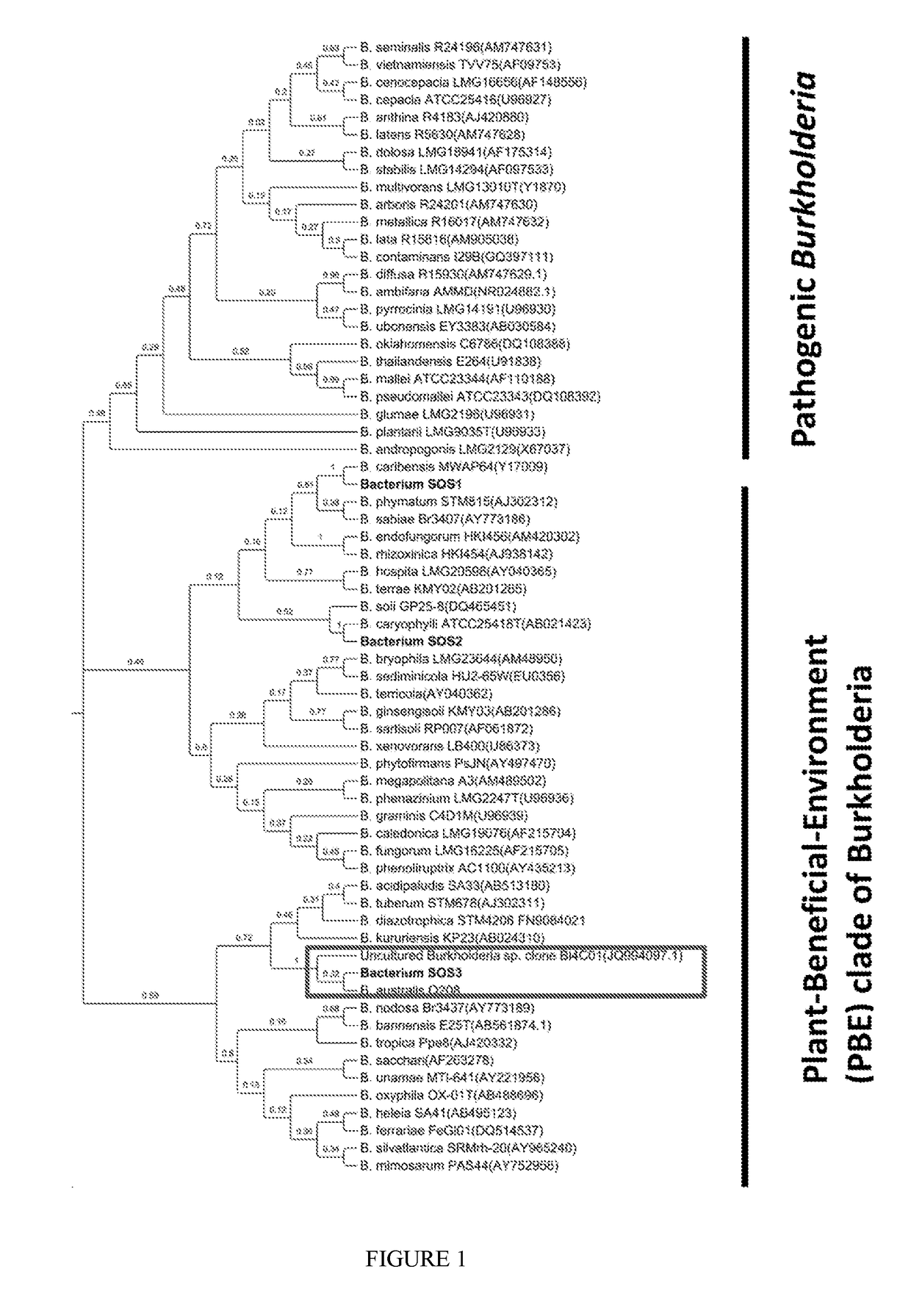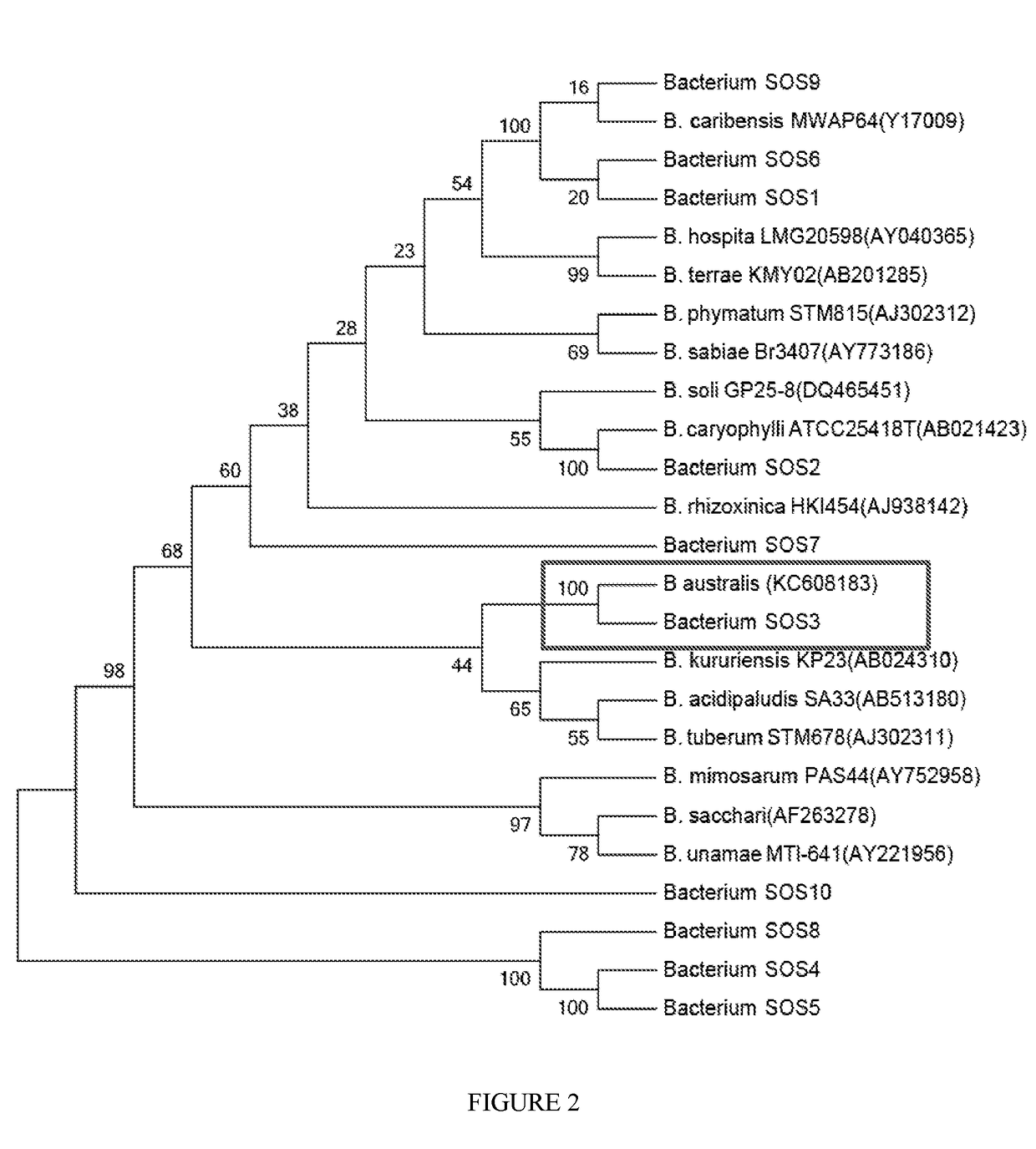Microbial inoculants, fertiliser compositions, growth mediums and methods for enhancing plant growth
a technology of inoculants and bacteria, applied in the field of microbial inoculants, fertiliser compositions and growth mediums, can solve the problems of environmental damage, long-term use of chemical fertilisers, and potential hazardous use of fertilisers, and achieve the effects of increasing plant growth, plant productivity, and seed germination or soil quality
- Summary
- Abstract
- Description
- Claims
- Application Information
AI Technical Summary
Benefits of technology
Problems solved by technology
Method used
Image
Examples
example 1
Strains and Maintenance of Culture
Microbial Strains.
[0143]The following microbial strains were used for treatment of seeds, seedlings and plants, and in the production of biofertilisers: Burkholderia australis Q208, Bacterium SOS1, Bacterium SOS2 and Bacterium SOS3 (BARS). Bacterium SOS1, Bacterium SOS2 and Bacterium SOS3 were isolated from the sugar cane and rice rhizospheres (in the case of Burkholderia australis Q208) and tomato rhizospheres (in the case of Bacterium SOS1, Bacterium SOS2 and Bacterium SOS3). Partial 16S rRNA sequencing indicated that the strains belong to the Plant-Beneficial-Environment (PBE) Burkholderia clade. Full sequencing of DNA confirmed that these bacteria are non-pathogenic microorganisms as they lack necessary genes for pathogenicity such as coding for components of T3SS and T4SS systems. When cultured aerobically on R2A media with the addition of phytate for 2 days at 28° C., BARS produce non-mucoid small and mucoid big colonies. Cells are Gram-negati...
example 4
on of the Hydroponic and Greenhouse Fertilisers
Composition of the Organic Phytate Biofertiliser (“Phytoliser”).
[0147]The biofertiliser for hydroponic and greenhouse applications (“phytoliser”) is a two-component system. It comprises of BARS at final concentration of 1×109 cell per ml, and of the organic matter described below, as liquid solution. The bacterial strains were grown and maintained as described in Example 1, and delivered to the trial spot as lyophilised powder. At the trial spot the bacteria were transferred to 100 ml of pure water (making 1×106 concentration) and left for 1 hr for their recovery. The organic matter (phytate) containing necessary chemical elements is manufactured from the plants, or from pig or chicken manure. The major component of the phytoliser is phytate, which represents the organic phosphorus stored by plants and abundantly found in different kinds of manures, plants and seeds. The phytoliser also contains a number of other chemical elements in th...
example 5
on and Preparation of Biofertilisers for Field Applications
Preparation of Biofertilizer.
[0149]BARS are mixed thoroughly with Alginate-humic acid mixture. This suspension was capsulated in the presence of solution of CaCl2, converting water-soluble sodium alginate into the water-insoluble calcium alginate beads. The beads are then coated with a mixture of phytate and manure, and air dried. Such biofertilizer pellets can be stored for months at room temperature. When pellets are applied to the wet soil, the bacteria start reviving and proliferating. Then, by direct contact with the roots the bacteria form biofilm on the roots, providing nutrients to the plants.
[0150]A further exemplary method for producing the biofertiliser is as follows. Alginate beads were prepared according to the methods outlined in Young et al. (Young C C, Rekha P D, Lai W A, Arun A B. Encapsulation of plant growth-promoting bacteria in alginate beads enriched with humic acid. Biotechnol Bioeng. 2006 Sep. 5; 95(1...
PUM
| Property | Measurement | Unit |
|---|---|---|
| time period | aaaaa | aaaaa |
| time period | aaaaa | aaaaa |
| temperature | aaaaa | aaaaa |
Abstract
Description
Claims
Application Information
 Login to View More
Login to View More - R&D
- Intellectual Property
- Life Sciences
- Materials
- Tech Scout
- Unparalleled Data Quality
- Higher Quality Content
- 60% Fewer Hallucinations
Browse by: Latest US Patents, China's latest patents, Technical Efficacy Thesaurus, Application Domain, Technology Topic, Popular Technical Reports.
© 2025 PatSnap. All rights reserved.Legal|Privacy policy|Modern Slavery Act Transparency Statement|Sitemap|About US| Contact US: help@patsnap.com



